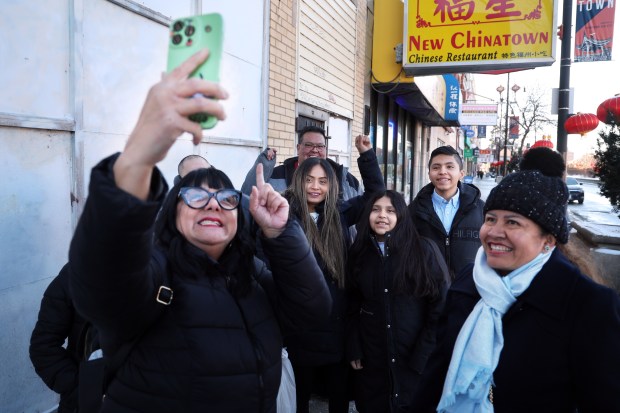Briseida de la Cruz Morales cried when she left her family’s Waukegan home for immigration court Thursday morning and said goodbye to her husband for what she believed would be the last time.
The 37-year-old from Mexico was scared to attend her Chicago court hearing, part of the process for people seeking asylum, or a form of protection granted to foreign nationals living in the United States and unable to return to their country due to past persecution or a fear of being persecuted in the future. Morales was worried that President Donald Trump’s policy changes around immigration could mean she would get deported Thursday.
But the family’s pastor in Waukegan encouraged her to go to court, assuring her she had a strong asylum case and would be at greater risk of deportation if she skipped the hearing. After weeks of build-up and hours of crying, she went to her hearing. And she left with a new court date for 2028 — not a deportation order.
“There are hundreds of people (in Waukegan) who don’t want to go to their court appointments out of fear,” said Julie Contreras, who leads United Giving Hope Church. “But it could be more devastating if they don’t go, because then a judge can issue a removal order.”
Despite Trump’s border czar Tom Homan promising immigration action that would create “shock and awe” — even allowing TV personality Phil McGraw to join enforcement raids across the Chicago area last month — and the new president’s continuous bombastic promises of a crackdown, immigration court in the city seems to mostly be operating as usual for asylum seekers.
But some immigration attorneys in Chicago warn that other immigrants who have had prior removal orders or are under Immigration and Customs Enforcement supervision are at greater risk of deportation under Trump. People who fall into this category have periodic check-ins with ICE — separate from immigration court, which is under the Department of Justice. They can now be put in expedited removal — a process where immigration officers can immediately remove certain noncitizens without a hearing.
Every immigration case is different and complex, lawyers and advocates said. Many times, it is up to the discretion of ICE agents to let someone stay in the country even if they have an order of removal.
How exactly this plays out in Chicago remains to be seen. But in some states,such as Georgia and South Carolina, attorneys say increased ICE operations are already more visible.
In those states, ICE is exercising more discretion to issue expedited removal orders, especially for people who have been in the U.S. for less than two years. ICE will also sometimes wait outside immigration courts to make arrests.
These practices haven’t largely seemed to impact immigration court in Chicago yet, attorneys say. They attribute this to Chicago’s sanctuary status, meaning city agencies are generally barred from cooperating with federal immigration authorities.
Still, stories of ICE pick-ups and expedited removals have in some cases led people to skip their immigration hearings in Chicago, said Victoria Carmona, director of the Chicago-Kent College of Law’s Immigration Law Clinic. In recent weeks, she said she’s had to file five motions to reopen cases where people skipped hearings, even though they had notice of their court dates. That’s an unusually high number, she said.
“People aren’t showing up … but then regret it later,” she said.
Carmona encouraged immigrants in asylum proceedings who are scared to come to court to look into doing hearings on WebEx, as recommended by the American Immigration Lawyers Association.
It’s not uncommon to miss an immigration hearing due to wanting to evade detection, said Kathleen Bush-Joseph, a lawyer and policy analyst at the Migration Policy Institute. But there are also other reasons for missing a hearing — late filing of documents and confusion about court dates.
Whether people skip their hearings out of fear or misunderstanding, of national removal orders issued from October to December, 71% were made “in absentia,” or because people didn’t show up. That percentage skyrocketed under former President Joe Biden. There is no public data yet for the first few weeks of Trump’s second presidential term.
“I think (the increase) reflects, more generally, how overwhelmed the whole system is: the courts, the lack of representation and a breakdown of DHS not being able to timely file documents it’s issuing,” Bush-Joseph said.
ICE check-ins
Unlike those requesting affirmative asylum like Morales, immigrants seeking green cards may be required to regularly check in with ICE.
They are now at greater risk of getting deported when they show up to their check-ins, said Chris Bergin, a longtime immigration lawyer who works with Centro Sin Fronteras, an organization that represents immigrants under deportation orders in Chicago.
They include immigrants sponsored by U.S. family members, victims of abuse under the Violence Against Women Act, immigrants seeking U Visas, nonimmigrant visas for victims of certain crimes who have experienced mental or physical abuse and T Visas, temporary visas for victims of human trafficking in the U.S.
Bergin said one of his clients, who has been under ICE supervision over the last decade, got a call from the agency last month asking her to go into its Chicago office. When the mother of two showed up, officials gave her a notice to leave the country in 30 days and put her in an ankle bracelet to ensure she wouldn’t flee or hide until she left the country back to her native El Salvador.
She has been in the U.S. since 2005 and has no criminal record. But because of complex immigration laws, she was given a deportation order after she submitted her application for a green card, Bergin said.
“We are being accused of harboring fugitives, but these people don’t have any criminal record,” he said.
Those who have received a prior order for deportation also need to check in with ICE. They can now be put in expedited removal, which means that even if they were allowed to stay under the agency’s discretion before, that is no longer the case, Bergin said.
When Bergin showed up to the local ICE agency with his client last month, he saw people leave in tears, many with ankle bracelets, he said. Officials will remove the bracelet at the airport before people board the plane for their deportation flight, he said.
Despite the risk, it is still better to abide by the law to have a chance to return to the U.S. legally again “one day,” said Eréndira Rendon, vice president of the Immigrant Justice at the Resurrection Project, a Chicago organization that provides access to legal resources for immigrants.
According to Rendon, it’s too soon to tell if the administration is actively using court appointments such as Morales’ to order people to leave. The Resurrection Project represents thousands of migrants applying for asylum and has not seen a pattern of denied cases so far. But those who have been under supervision for years, mostly Mexican immigrants, do face the risk of deportation, Rendon said.
For many, showing up to their ICE check-in is a chance to leave the country without being put in chains and handcuffs, Bergin said. Others, he said, are choosing to skip their check-in, which means they must hide or move to keep ICE from knocking on their door.
Court on Thursday
Morales said she was dreading her immigration court hearing. She was scared of losing everything she had worked to build in Waukegan.
But at the urging of Contreras, Morales went to court at the Department of Homeland Security’s Offices in the Loop Thursday. DHS is the federal agency that oversees ICE.
She pulled her two kids — Edith, 12 and Christian, 15 — out of school to join her. They said goodbye to their father that morning, who they said has a separate asylum case.

“We are hard-working, honest people … fleeing from our country. We are not criminals, we haven’t harmed anyone, and we are here asking for a second chance,” Morales said as she stood outside Chicago’s immigration court in the Loop in the freezing cold, tears in her eyes.
She said she and her husband Sergio Sanchez Salgado, 39, ran a liquor store in Cuernavaca, Mexico, before cartel groups came to the doors of their business demanding they pay extortion fees. They refused, and the cartel threatened their children.
In 2023, the threats became worse and they decided to move to Waukegan where Salgado had family. They arrived on Jan. 26 that year.
Several members of United Giving Hope Church joined Pastor Contreras, Morales and her kids in solidarity Thursday. The group went through the metal detectors at the federal building and security guards wished them luck.
They prayed in a big circle before getting in the elevator to go to court on the third floor. There were so many people attending the hearing they couldn’t all fit.
The group was then ushered into the courtroom, where immigration Judge Ana Mencini was presiding. A court interpreter sat next to her and translated, and families and children crowded in rows on wooden benches waiting for their cases to be called.
When Morales heard her name, she went up to a table and sat facing Mencini, her two children seated next to her. Morales had filed her asylum application and paid for an attorney, who joined the hearing virtually from Florida.
Mencini said she saw no logistical issues with Morales’ asylum claim. Mencini took the necessary steps to move forward with the immigration process and told Morales that in the future her children did not need to skip school to attend court.
“We’re ready to set this to an individual (hearing),” Mencini said. “How is April 28, 2028, at 1 p.m.?”
Relief came over Morales’ face as she walked back to the group of church congregants who had been anxiously waiting in the back of the crowded courtroom. They left, and Morales’ children hugged their mom. Contreras said they would go out to lunch in Chinatown to celebrate.
In the elevator on the way out of court, Martin Perez, an attorney who was there representing a different party on Thursday, said his clients have experienced the same fear as Morales. He reiterated Contreras’ message to continue attending immigration hearings despite fear.
“I’m advising people to get their documents in order, get their evidence in order. I’m advising them to continue to fight their cases and to make sure that they provide their attorneys with all the details,” he said.
Christian, 15, said it was his first time in court. When the judge moved his family’s case along, it “meant a lot,” he said.
“We went through many terrible things, and we just don’t want to go through them again,” he said.
Friday, he and his sister went back to school. Christian said he’s made a lot of friends at Waukegan High School and has been getting good grades. He said his English is getting better.





